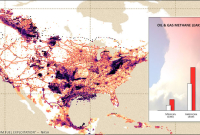This story was originally published by The Guardian and appears here as part of the Climate Desk collaboration.
The damage caused by the climate crisis through extreme weather has cost $16 million (£13 million) an hour for the past 20 years, according to a new estimate.
Storms, floods, heat waves and droughts have taken many lives and destroyed swathes of property in recent decades, with global heating making the events more frequent and intense. The study is the first to calculate a global figure for the increased costs directly attributable to human-caused global heating.
It found average costs of $140 billion (£115 billion) a year from 2000 to 2019, although the figure varies significantly from year to year. The latest data shows $280 billion in costs in 2022. The researchers said lack of data, particularly in low-income countries, meant the figures were likely to be seriously underestimated. Additional climate costs, such as from crop yield declines and sea level rise, were also not included.
The researchers produced the estimates by combining data on how much global heating worsened extreme weather events with economic data on losses. The study also found that the number of people affected by extreme weather because of the climate crisis was 1.2 billion over two decades.
Two-thirds of the damage costs were due to the lives lost, while a third was due to property and other assets being destroyed. Storms, such as hurricane Harvey and cyclone Nargis, were responsible for two-thirds of the climate costs, with 16 per cent from heat waves and 10 per cent from floods and droughts.

The researchers said their methods could be used to calculate how much funding was needed for a loss and damage fund established at the UN’s climate summit in 2022, which is intended to pay for the recovery from extreme weather disasters in poorer countries. It could also rapidly determine the specific climate cost of individual disasters, enabling faster delivery of funds.
“The headline number is $140 billion a year and, first of all, that’s already a big number,” said Prof. Ilan Noy at the Victoria University of Wellington in New Zealand, who carried out the study with colleague Rebecca Newman. “Second, when you compare it to the standard quantification of the cost of climate change [using computer models], it seems those quantifications are underestimating the impact of climate change.”
Noy said there were a lot of extreme weather events for which there was no data on the number of people killed or economic damage: “That indicates our headline number of $140 billion is a significant understatement.” For example, he said, heat wave death data was only available in Europe. “We have no idea how many people died from heat waves in all of sub-Saharan Africa.”
There has been a sevenfold increase in reported losses from extreme weather disasters since the 1970s, according to the World Meteorological Organization. However, separating the effect of global heating from population growth, urban migration and better reporting of disasters is difficult.
The study, published in the journal Nature Communications, took a different approach based on how climate change had exacerbated extreme weather events. Hundreds of “attribution” studies have been done, calculating how much more frequent global heating made extreme weather events. This allows the fraction of the damages resulting from human-caused heating to be estimated.
The researchers applied these fractions to the damages recorded in the International Disaster Database, which compiles available data on all disasters in which 10 people died, or 100 were affected, or the country declared a state of emergency or requested international assistance.
The central estimate was an average climate cost of $140 billion a year, with a range from $60 billion to $230 billion. These estimates are much higher than those from computer models, which are based on changes in average global temperature rather than on the extreme temperatures increasingly being seen in the world.
The years with the highest overall climate costs were 2003 when a heat wave struck Europe; 2008, when cyclone Nargis hit Myanmar; and 2010, when drought hit Somalia and a heat wave hit Russia. Property damages were higher in 2005 and 2017 when hurricanes hit the U.S., where property values are high.
The analysis used a statistical value of a life lost of $7 million, an average of the figures used by the U.S. and U.K. governments. “A lot of people are very uncomfortable with the idea that we put a price tag on a life,” said Noy. “But this is very standard economic practice and comes about because, ultimately, we need to make decisions about [the value of] investments in various things.”
Noy said that only considering the economic damage caused to infrastructure would heavily skew the cost estimates to rich countries, despite much of the damage from extreme weather hitting poorer ones. He contrasted the $140 billion damage estimate with the $100 billion promised by rich countries to poorer ones, but yet to be delivered in full, and noted that 90 per cent of that money was for cutting emissions. The figures also contrast with the subsidies of $7 trillion a year enjoyed by the fossil fuel industry.
At the UN Climate Summit, COP27, in 2022, countries agreed to set up a loss and damage fund to help poorer ones rebuild after climate-related disasters. “You can use our methodology to start putting numbers on how much money we need in the fund,” Noy said.
Ideally, he said, a quick attribution study on an extreme weather event would estimate the climate-related damage and lead to a rapid delivery of funds: “It would be a kind of insurance scheme for countries.” The methodology might also be useful for determining damages in climate lawsuits, he said.
Dr. Stéphane Hallegatte, at the World Bank and not part of the study team, said: “The key message is that climate change is visibly increasing global economic losses from disasters. This has been a topic of controversy, with some claiming that climate change effects are negligible compared with other factors like economic growth and urbanization.
“This study looks at the attribution for the physical event — it’s much simpler, robust, and it provides a convincing case. It is an emerging field and uncertainties are really large. One lesson of the study is that global research centres — mostly located in rich countries — need to work more on what is happening in poorer countries.”






Comments